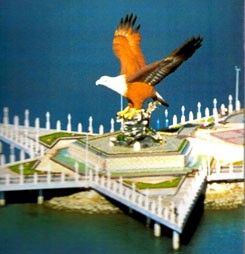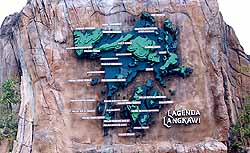
|
| Home | About Langkawi | Activities | Places of Interest | Shopping | Packages | Contact | Map | |
Kuah
The main town is located on the south-eastern
tip of Pulau Langkawi. The Kuah jetty is the landing point for boats to the
neighbouring islands. The name 'Kuah' is a Malay word meaning 'gravy' and is
associated with an ancient legend of two battling giants who overturned a
gigantic pot of curry (kuah) at the spot where the town now stands.
Once a rustic town with few streets, present day Kuah is a thriving centre of
modern hotels and shopping-cum-business complexes, but without the over-crowding
and bustle of modern cities.
Kuah is a duty free shopping haven with a wide variety of goods sold at attractive prices and its restaurants offer excellent culinary delights, especially fresh seafood.

Dataran Lang (Eagle Square) is Langkawi's most prominent landmark for visitors arriving by sea.
Situated near the Kuah jetty, the main attraction of the square is the magnificent statue of the reddish brown eagle majestically poised for flight. According to local folklore, Langkawi derived its name from the eagle or "helang". In old Malay, "kawi" denote reddish brown - hence, Langkawi means reddish brown eagle!
The square is beautifully landscaped and features scenic ponds, bridges, covered terraces, restaurants and barrel vaults made of bricks. Its close proximity to the sea and the soft breezes make it an ideal spot for leisurely walks and a tranquil setting for dining in the cool evenings. The square is beautifully illuminated at night and presents a dramatic scene as you approach the island by sea. Indeed, the majestic eagle is strategically positioned to welcome visitors to Langkawi.


Langkawi's "Legend On The
Park" is more than just a scenic park with beautiful gardens of vivid
local blooms, plants and fruit trees. It is a 50-acre park with 17 story-telling
monuments, 4 artifical lakes and a man-made beach which provide a
picturesque and fitting backdrop for buildings showcasing Malaysia's rich
cultural heritage.
Within the park, there are also some fine examples of traditional Malaysian handicraft and cultural objects.